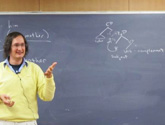- HOME
- Japanese Top
- Eibei GP
- English Top
- Lectures
- GP Lecture Series 1


| Date and Time | January 18th , 2010 (Tue), 15:15-16:45 |
|---|---|
| Place | Nanzan University, Nagoya Campus, MB1 |
| Guest Lecturer | Dr. Christopher Tancredi (Keio University) "Condition B as an Epiphenomenon" |
| Hosting Professor | Dr. Tatsuya Suzuki (Chair of the Department of British and American Studies) |
Following Chomsky(1981), generative grammar classifies nouns phrases into an anaphor, a pronominal., and an R-expression, and tries to account for their distribution by Binding Conditions A, B, and C, respectively. In this lecture Professor Tancredi, who reexamines binding through the perspective of the most recent linguistic theory, proposes that Binding Condition B, which deals with pronominals, does not have to be postulated as a binding condition.
 Dr. Christopher Tancredi. |
 The lecture in progress. |
 GP Student Reporter. |
Dr. Christopher Tancredi's Lecture.
Generative Grammar has divided referential expressions (Noun Phrases) into three categories: anaphors (e.g. himself, herself), pronouns (e.g. he, she), and R-expressions, or referring expressions,(e.g. John, Mary) since Chomsky introduced the Theory of Government and Binding in 1981. The theory explains where these three categories are appropriately used in reference to the three conditions: Binding Condition A (anaphors have to be bound in a local domain), Binding Condition B (pronouns have to be free (i.e. not bound)), and Binding Condition C (R-expressions have to be free everywhere). The idea of “bound” is technically defined in the theory. In simpler words, Condition A says that anaphors must have their antecedents close enough, whereas Condition B says that pronouns must not have their antecedents too close. In the case of Condition C, R-expressions must not have their antecedents in the same sentences. Dr. Tancredi proposed a different view on the binding phenomena. He claimed that there are two types of referring expressions that may be linked to antecedents, one restricted to applying within a sentence, and one capable of referring back to expressions in the discourse context. In Dr. Tancredi’s theory, pronouns exclusively belong to the second type, and therefore Condition B concerning pronouns must be treated differently from Condition A and Condition C. He explained the related facts in terms of processing effects based on a phase-by-phase approach to discourse augmentation in a technical sense. So considering what we have said above, we may say Condition B is not an independent binding condition, and therefore Condition B becomes an epiphenomenon(=a secondary phenomenon accompanying another phenomenon).